Claude Monet, often hailed as the father of Impressionism, revolutionized the art world with his innovative techniques and dedication to capturing the fleeting beauty of light, color, and nature. His works, including the iconic Water Lilies series, have become synonymous with Impressionism. This art movement broke away from traditional academic painting and embraced the ephemeral qualities of the world.
Monet’s journey as an artist was one of persistence, experimentation, and a deep connection to his surroundings. His groundbreaking approach to painting not only defined Impressionism but also paved the way for modern art. In this blog post, we’ll explore Monet’s life, his artistic techniques, his most famous works, and the lasting impact he had on the art world.
Table of Contents
- Who Was Claude Monet?
- The Birth of Impressionism
- Monet’s Artistic Techniques
- Monet’s Famous Works
- Monet’s Garden at Giverny
- Monet’s Legacy
- 15 FAQs About Claude Monet and Impressionism
- Related Questions
Who Was Claude Monet?
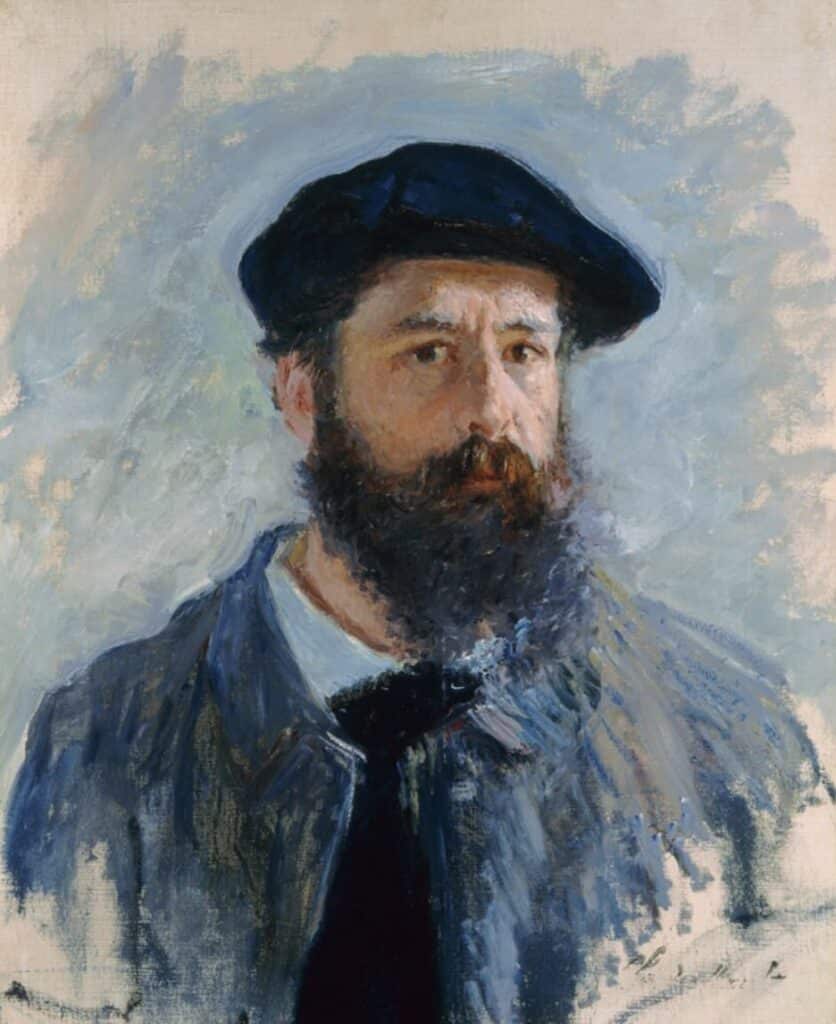
Claude Monet was born on November 14, 1840, in Paris, France. However, he spent much of his childhood in Le Havre, a coastal town in Normandy. From a young age, Monet displayed a talent for art, particularly in drawing caricatures. His early interest in art was encouraged by Eugène Boudin, a local artist who introduced him to plein air (outdoor) painting.
Monet’s artistic journey took him to Paris, where he studied at the Académie Suisse and met other young artists who would later become key figures in the Impressionist movement, including Pierre-Auguste Renoir, Alfred Sisley, and Camille Pissarro.
The Birth of Impressionism
What Is Impressionism?
Impressionism was a radical art movement that emerged in the late 19th century. It rejected the rigid rules of academic painting, which emphasized historical and religious subjects, precise detail, and polished finishes. Instead, Impressionists sought to capture the transient effects of light, color, and atmosphere, often painting en plein air to depict scenes from everyday life.
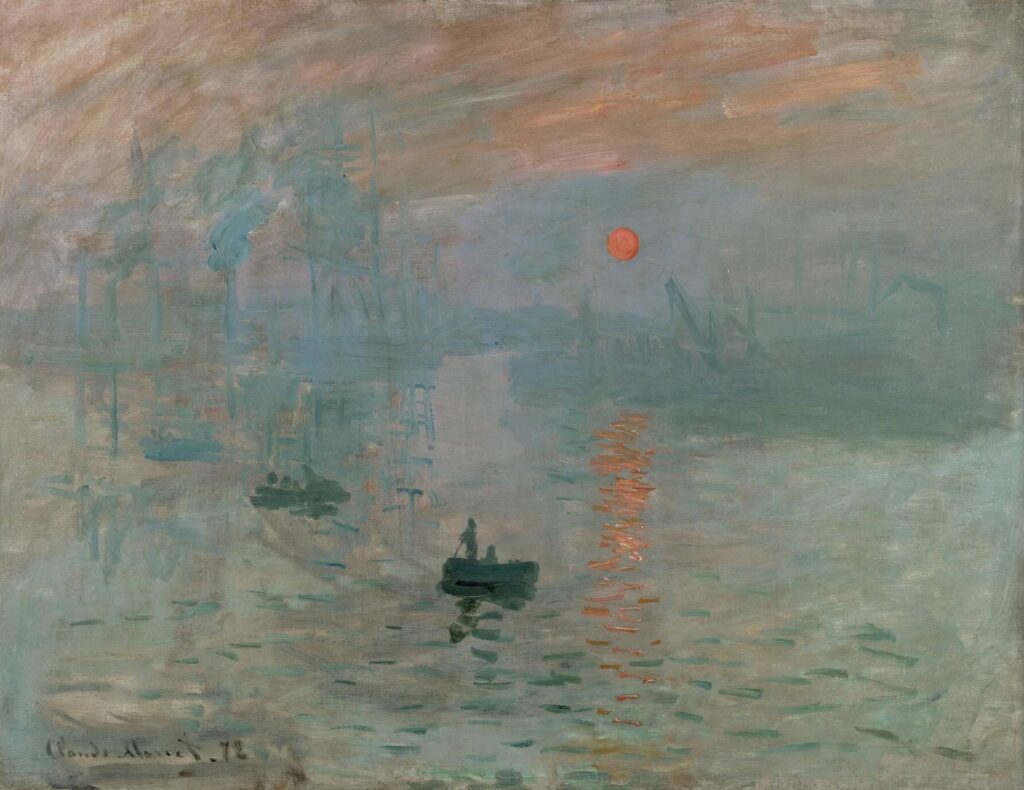
The movement derived its name from Monet’s painting “Impression, Sunrise” (1872), which was exhibited at the first Impressionist exhibition in 1874. Critics initially used the term “Impressionism” as a derogatory label, mocking the unfinished, sketch-like quality of the works. However, the artists embraced the term, and it became synonymous with their innovative approach to art.
Monet’s Role in Impressionism
Monet was a central figure in the Impressionist movement, both as an artist and as a leader of the movement. His dedication to capturing the effects of light and atmosphere set the tone for the movement, and his works exemplified its principles.
Monet’s paintings were characterized by loose brushwork, vibrant colors, and a focus on the sensory experience of a moment rather than precise detail.
Monet’s Artistic Techniques
Monet’s innovative techniques were key to his success and influence. Here are some of the defining features of his art:
1. Plein Air Painting
Monet often painted outdoors, directly observing his subjects in natural light. This approach allowed him to capture the changing effects of light and atmosphere with immediacy and authenticity.
2. Focus on Light and Color
Monet was fascinated by the interplay of light and color. He used broken brushstrokes and pure, unmixed colors to create a shimmering effect, capturing the way light changes throughout the day.
3. Series Paintings
Monet often painted the same subject multiple times under different lighting and weather conditions. His series of paintings, such as the Stacks of Wheat (End of Summer) – 1985, demonstrate his obsession with the passage of time and the ephemeral nature of light.
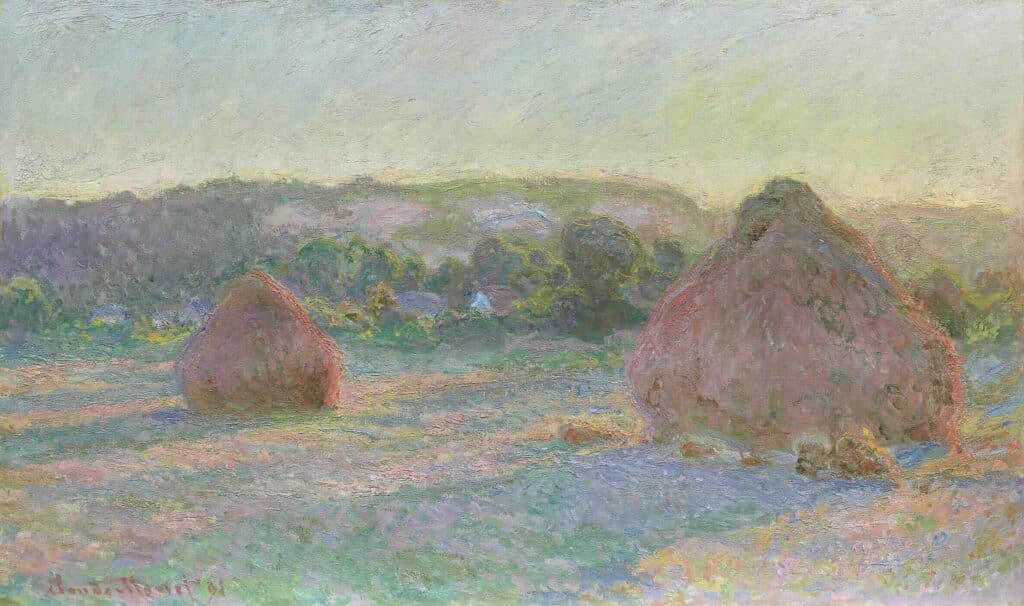
4. Loose Brushwork
Monet’s brushwork was loose and expressive, prioritizing the overall impression of a scene over fine detail. This technique gave his paintings a sense of movement and vitality.
5. Innovative Use of Perspective
Monet often experimented with unconventional perspectives, drawing the viewer’s eye into the scene and creating a sense of immersion.
Monet’s Famous Works
1. Impression, Sunrise (1872)

This painting, which gave the Impressionist movement its name, depicts the port of Le Havre at sunrise. Monet’s use of loose brushstrokes and subtle color gradients captures the atmospheric effects of the morning light.
2. The Woman with a Parasol (1875)
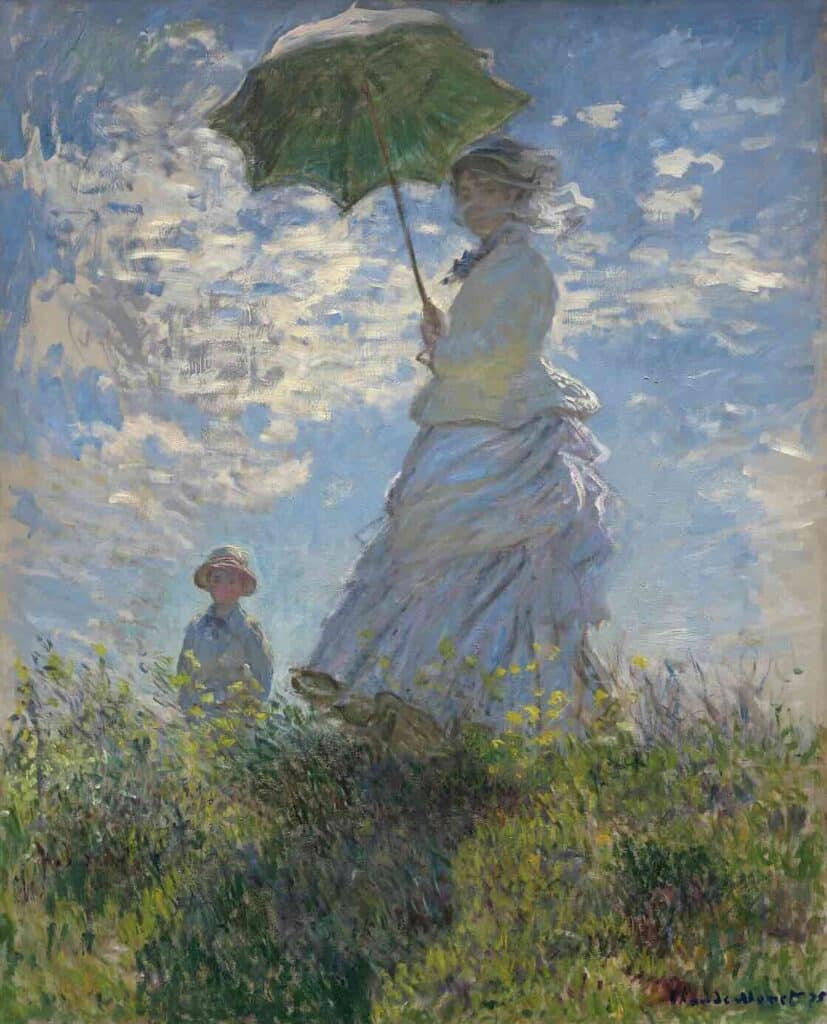
This iconic painting portrays Monet’s wife, Camille, and their son on a windy day. The dynamic brushwork and vibrant colors convey the movement of the breeze and the warmth of the sunlight.
3. Haystacks Series (1890–1891)

Monet’s Haystacks series comprises 25 paintings, each depicting the same haystack under varying lighting and weather conditions. These works exemplify Monet’s fascination with the passage of time and the effects of light.
4. Rouen Cathedral Series (1892–1894)
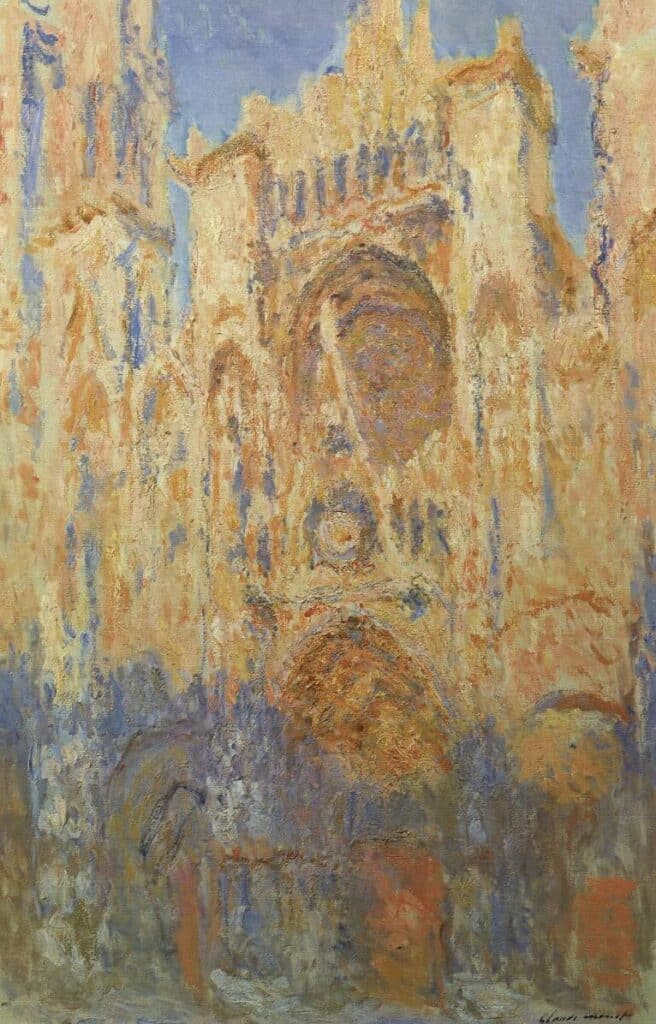
Monet painted over 30 views of Rouen Cathedral, capturing its façade at different times of day and in various weather conditions. The series is a masterful study of light, texture, and atmosphere.
5. Water Lilies Series (1897–1926)
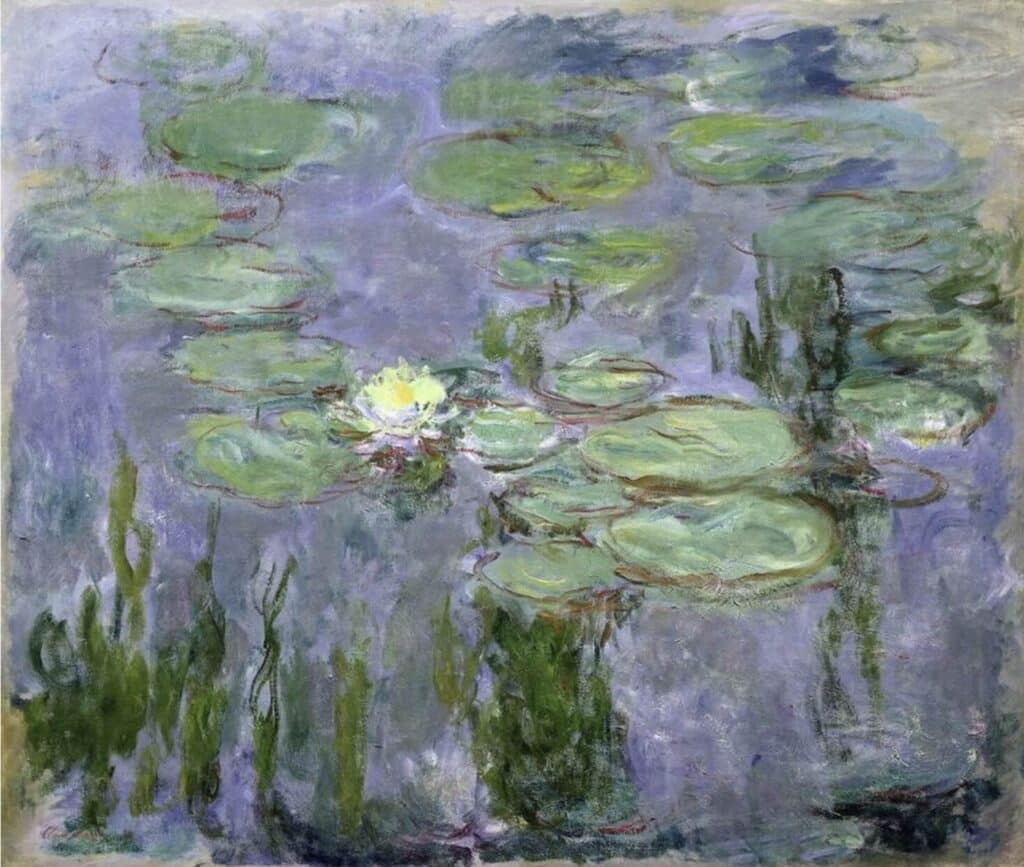
Perhaps Monet’s most famous works, the Water Lilies series consists of around 250 paintings depicting the lily pond in his garden at Giverny. These paintings are celebrated for their ethereal beauty and meditative quality, capturing the reflections of light and sky on the water’s surface.
Monet’s Garden at Giverny
Monet’s home and garden in Giverny were a constant source of inspiration for his art. He meticulously designed the garden, planting flowers, trees, and water lilies to create a living masterpiece. The Japanese bridge and lily pond became iconic motifs in his paintings, symbolizing his deep connection to nature and his ability to transform ordinary scenes into extraordinary works of art.
Monet’s garden at Giverny remains a popular destination for art lovers and tourists, offering a glimpse into the world that inspired some of his greatest works.
Monet’s Legacy
Monet’s influence on the art world cannot be overstated. His dedication to capturing the fleeting beauty of light and color revolutionized the way artists approached their craft, paving the way for modern art movements such as Post-Impressionism, Fauvism, and Abstract Expressionism.
Impact on Modern Art
Monet’s focus on the sensory experience of a moment inspired artists to experiment with new techniques and perspectives. His loose brushwork and emphasis on color over detail influenced movements like Fauvism and Abstract Expressionism, which prioritized emotion and visual impact over realism.
Cultural Significance
Monet’s works continue to captivate audiences worldwide, celebrated for their beauty, innovation, and timeless appeal. His paintings are housed in major museums, including the Musée d’Orsay in Paris, the Metropolitan Museum of Art in New York, and the National Gallery in London.
Monet’s Enduring Appeal
Monet’s art resonates with viewers because it captures universal experiences—the warmth of sunlight, the tranquility of water, the fleeting beauty of nature. His ability to evoke emotion and connect with his audience ensures that his works remain relevant and beloved.
15 FAQs About Claude Monet and Impressionism
Who Was Claude Monet?
Claude Monet was a French painter and a founding figure of the Impressionist movement, known for his innovative techniques and focus on light, color, and nature.
What Is Impressionism?
Impressionism is an art movement that emerged in the late 19th century, emphasizing the transient effects of light, color, and atmosphere over precise detail and traditional academic techniques.
Why Is Monet Called the Father of Impressionism?
Monet is called the father of Impressionism because his painting Impression, Sunrise (1872) inspired the movement’s name and exemplified its principles.
What Are Monet’s Most Famous Works?
Monet’s most famous works include Impression, Sunrise, Water Lilies, Haystacks, Rouen Cathedral, and The Woman with a Parasol.
What Techniques Did Monet Use?
Monet used techniques such as plein air painting, loose brushwork, vibrant colors, and innovative perspectives to capture the ephemeral qualities of light and atmosphere.
What Inspired Monet’s Art?
Monet was inspired by nature, particularly his garden at Giverny, as well as the changing effects of light and color in his surroundings.
What Is Plein Air Painting?
Plein air painting is the practice of painting outdoors, directly observing the subject in natural light. Monet often painted en plein air to capture the immediacy of a scene.
What Is the Water Lilies Series?
The Water Lilies series is a collection of around 250 paintings depicting the lily pond in Monet’s garden at Giverny, celebrated for their beauty and meditative quality.
How Did Monet Influence Modern Art?
Monet’s focus on light, color, and sensory experience profoundly influenced modern art movements, including Post-Impressionism, Fauvism, and Abstract Expressionism.
Where Can I See Monet’s Paintings?
Monet’s paintings are housed in major museums worldwide, including the Musée d’Orsay in Paris, the Metropolitan Museum of Art in New York, and the National Gallery in London.
What Is Impression, Sunrise?
Impression, Sunrise is a painting by Monet that depicts the port of Le Havre at sunrise. It inspired the name of the Impressionist movement.
What Was Monet’s Garden Like?
Monet’s garden at Giverny featured a lily pond, a Japanese bridge, and a variety of flowers and trees, serving as a constant source of inspiration for his art.
Why Was Impressionism Controversial?
Impressionism was controversial because it rejected the traditional rules of academic painting, favoring loose brushwork and everyday subjects over historical and religious themes.
What Is the Legacy of Impressionism?
Impressionism revolutionized the art world, influencing modern art movements and changing the way artists approach light, color, and composition.
Why Is Monet Still Relevant Today?
Monet’s art is still relevant because it captures universal experiences and emotions, inspiring viewers with its beauty, innovation, and timeless appeal.
Claude Monet’s journey through art was one of innovation, persistence, and a deep connection to nature.
As the father of Impressionism, he transformed the art world, challenging traditional norms and inspiring generations of artists. His works, from the iconic Impression, Sunrise to the serene Water Lilies, continue to captivate audiences with their beauty and emotional resonance.
Monet’s legacy is a testament to the power of art to capture the fleeting beauty of life and connect us to the world around us. By stepping into Monet’s world, we not only discover the birth of Impressionism but also gain a deeper appreciation for the enduring magic of light, color, and nature.
Anita Louise Art is dedicated to art education, great artists, and inspiring others to find and create their art. We love art that uplifts and inspires. #ArtToMakeYouSmile! #ArtToMakeYouHappy!
If you want to see any of my art, you can find out more by clicking here. If you are interested in what inspires me and my paintings, you can discover more by clicking here.
We have a free newsletter and would love you to be part of our community; you can subscribe to the newsletter by clicking here. If you have any questions, I would be happy to talk to you anytime. You can reach me, Anita, by clicking here.
Subscribe to our Anita Louise Art YouTube Channel with great videos and information by clicking here.
Join us for our podcast “5 Minutes With Art.” Spend just 5 minutes a week with us to discover and learn about great art and artists. You can find out more about our podcast by clicking here.
Related Questions
Creating An Artist Brand And Website, What You Need To Know
As an artist, you must look at your brand and decide how you want others to see your brand. Then you need to consider what domain name you will have for your artistic branding. Choosing the wrong domain name can cause problems or a headache for years. Then, you need to decide what kind of website hosting and service you will use. All of this is an essential aspect of you selling your art.
By clicking here, you can learn more by reading Creating An Artist Brand And Website, What You Need To Know.
7 Women Impressionist Artists, To Admire, Know and Remember
The seven significant women of impressionist painters are Berthe Morisot, Mary Stevenson Cassatt, Marie Bracquemond, Louise Catherine Breslau, Eva Gonzales, and Lilla Cabot Perry. In their unique ways, Each of these women contributed to impressionism art.
By clicking here, you can learn more by reading 7 Women Impressionist Artists, To Admire, Know and Remember.
17 Facts About the American Gothic Painting by Grant Wood
Grant Wood’s painting, the American Gothic, has a Carpenter Gothic Style house with a stoic man with a pitchfork and women staring off to the side painted outside their house. The American Gothic painting has a lot of ambiguity associated with it, which has lead to speculation about its true meaning; all this ambiguity has raised the painting’s profile over the years. The painting received a 3rd place finish in an art competition at the Art Institute of Chicago.
By clicking here, you can learn more by reading 17 Facts About the American Gothic Painting by Grant Wood.

